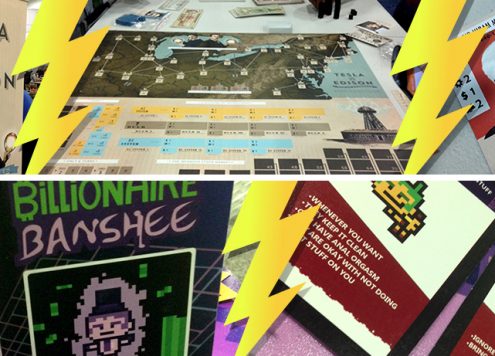ORIGINS GAME FAIR, July 11-15 at the Greater Columbus Convention Center
by David C. Obenour
The annual warm up for Gen Con, what Origins lacks in size it delivers in less crowded halls and less hurried play-testing tables. Having to awkwardly defend your space behind a fellow gamer for 15 minutes while they finish their play-test isn’t much fun and neither is having someone lurk over you when it is your turn to play. So taking advantage of this more laid back convention, Ghettoblaster was able to get in a whole lot of gaming! Not all of the games featured here are brand new, but they were new to us and maybe you too.
Also, it’s worth mentioning that there’s a lot more to do at Origins besides just playing games and some of our past reviews have covered all of the great food and fun that surrounds this five-day event (see Origins 2012: Day One).
But without any further ado, onto the games!
KAOSBALL (CoolMiniOrNot, 2014)

CoolMinisOrNot lives up to the first half of its name with the new, Kickstarter funded, Kaosball! Sure the base set with a board, rules and four teams retails for a hundred clams, but as a parental figure may or may not have told you growing up: you get what you pay for. Fantasy teams made of trolls, lycantropes, valkyries, cowboys, steampunks and more, all battle for your insatiable appetite for blood sport. Players control runners, bruisers and ringers as they fight, steal and tackle their way to possessing the ball and holding on for dear life, and points, atop of the scoring zones. Each team has their own special rules, and cool figures too, so Kaosball can potentially be a dangerous cash sink, but when you’re having this much fun…
RIVET WARS (CoolMiniOrNot, 2013)

Let’s time warp back a year (and to last review): CoolMinisOrNot lives up to the first half of its name with a previously successfully Kickstarter funded project, Rivet Wars! While steampunk is a pretty polarizing style, the World War I fashioned robo-minis made for Rivet Wars are pretty undeniable awesome looking. Infantry, artillery and vaguerly tank-ish looking contraptions fight through trenches and over hill and dale as provided by the nine double-sided battlefield terrain tiles. Unlike some military tabletop games, the rules are fairly uniform and simple, plus the battlefield is grid-ed out so you don’t need a tape measure for shooting or movement. Again, retail for this starting game set is $100 (though Amazon has it new for only $70) and again with a number of additional expansions with more cool minis it’s a potential cash sink… but also again, fun.
XENOSHYFT ONSLAUGHT (CoolMiniOrNot, 2014)

The ‘get your attention while walking through the Exhibitor Hall’ pitch is that Xenoshyft Onslaught is a cooperative, deck-building, tower defense game. For those of you not fluent in geek, that means you’re using a starting deck to acquire more and better cards, using those cards to stop your enemy, and all working together as a team. Concept-wise, Xenoshyft is pure Avatar. Humans have scoured the galaxy, seeking out resources, and in this case, are mining a planet dry of its inhabitant’s main food source. Players take the role of department heads (Med Bay, Weapons Research, Science Lab and Armory) for the company, NorTec Military. Each round a new wave of sunken-eyed, famished aliens assault the base and players must work together to defend each other and the base. It’s not easy, and you can tell the designers wanted you to feel torn about what it is your actually doing, but it’s still fun.
FREEDOM: THE UNDERGROUND RAILROAD (Academy, 2012)

Freedom: The Underground Railroad is a remarkably well-made game. For all of the mindfully-done and historically influenced mechanics that it employs, once the turn order is ran through and understood the game plays fairly intuitively. Not getting bogged down in complex decision making minutia allows players to appreciate Freedom both as a game and as a look back at a time when America was most divided. Taking on the role of historical figures from the abolitionist movement, players work cooperatively to help guide escaped slaves along the Underground Railroad while evading slave catchers, and work to raise funds and support for the cause. Each character has his or her own special abilities, so a smart group utilizes their individual strengths to help the team. The main possible flaw for Freedom comes with this, as it does with most cooperative games, in an overly controlling alpha player can easily takes the reigns if not checked.
STAR REALMS (White Wizard Games, 2014)

A head-to-head deck builder, Star Realms is deceptively simple and insanely addictive. Players take on the role of star fleet admirals and amass ship and base cards. Most all cards come with an alignment (either The Trade Federation, The Blobs, The Star Empire or The Machine Cult) and the more cards you’re able to play in a turn from the same alignment the more bonuses you receive – drawing more cards, additional attacks, higher purchasing power, etc. The starter set for a 2-player games is only $15. Want to add a third or fourth player? All you have to do is buy another set! There’s really not much else to say about Star Realms or maybe there is but writing about the game just makes me want to go play it again… I’ll be right back.
QUILT SHOW (Rio Grande Games, 2014)

Admittedly, a game about competitive quilting doesn’t sound all that exciting at first but then a new game from Rio Grande sure does! Designed with the help of longtime quilting advocate and designer, Judy Martin (having published the most number of original patterns, she’s the Robert Pollard of quilting) Quilt Show is a fun little game. Players collect scraps of different colored fabric, much like collecting different colors of trains in Ticket to Ride, and use these combinations to acquire quilt square tiles of varying intricacy and point value. After a set number of quilt squares have been made, the first of three quilt shows is triggered. Players arrange their squares in patterns either different or alike, add up their quilts’ point value and ribbons and cash prizes are awarded. The fun twist here is that your unused fabric cards and quilting squares carry over to the next show, so while you might not have done well this time you’re in a much better position for the next show.
COPYCAT (Rio Grande Games, 2012)

The overall concept of Copycat matches its theme completely. Designer Friedemann Friese took all of the best mechanics from some of our favorite games – Dominion, Agricola, Through the Ages, Puerto Rico and Power Grid – and implemented them for a game about political campaigning. Benefit from and then take credit for the work of others. Perfect, right? Friese’s work isn’t completely void of it’s own inspiration though. While a lot of games can suffer from this sort of direct… copycatting, Copycat borrows enough different mechanics and uses them in a way that you never find your mind wandering to thoughts like “this is fun, but I’d rather just be playing…” or “I already kind of own this.”
TSURO OF THE SEAS (Calliope Games, 2012)

Tsuro of the Seas takes much of its game play from the classic 2004 puzzle game, Tsuro. Players place tiles with interweaving paths, trying to keep those paths from the edge of the board for as long as possible. However, with the seas come monstrous daikaijus that add an element of randomness to play by devouring ships whenever their paths cross. The Veterans of the Seas expansion (2013) adds even more twists with Tsunami, Uzushio (Whirlpool), Taihou (Cannons) and Mystic Portal tiles. Ultimately, a lot of the original Tsuro’s beauty lay in its simplicity so Tsuro of the Seas’ variants, while interesting and beautifully designed, only clutter the concept.
RARRR!!! (APE Games, 2014)

The Zombie tide has crested (or at least plateaued) and rising from the murky depths to challenge the undead’s pop-culture dominance is the mighty daikaiju. While a constant staple, over the last few years Godzilla and the Godzilla-like have been gaining more and more favor as the next big nerd theme. The aptly named Rarrr!!! starts with players building their Japanese movie monsters by drafting single syllable cards (creating fun names and divvying out electrical, toxic, radioactive and fire powers). After your monster is created another round of drafting creates your starting hand of power cards and you’re ready to clash over the major cities of Earth. Though different in its play mechanics, there did seem to be a fair amount of similarities in the look and feel to iello’s 2011 game, King of Tokyo. That said, there’s probably enough room for two hulking monsters on your gaming shelf.
The games of Origins, 2014









Social Media